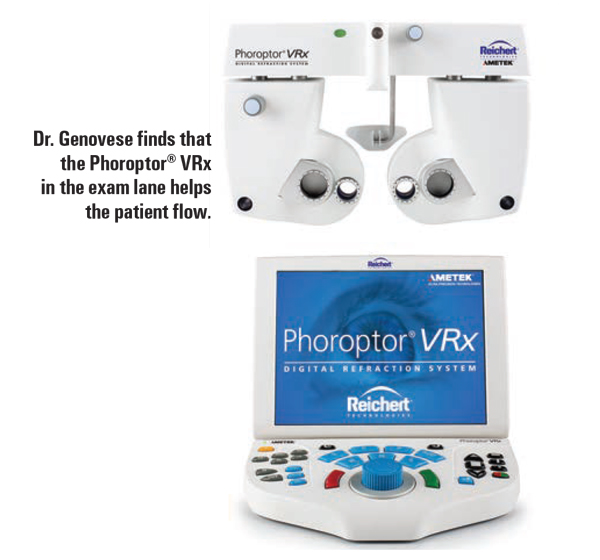

When Lisa Genovese, OD, and her husband, Jason MacLaughlin, OD, purchased a two-location practice from an optician who had owned the business for 30 years, they knew they couldn’t make too many changes too quickly. But some changes were necessary. “An optometrist came to the office once a week. There was no autorefractor; there was no electronic medical records system. We were inheriting a patient base that wasn’t accustomed to technology,” she recalls. The first year they owned it, the goal was to win over the patient base. That apparently worked, she says, as Insight Eye Care in Lockport and Williamsville, New York, has tripled its patient base with the new services they’ve added.
Some of their additions were in terms of doctor-power: Adrienne Cassata, OD, is a pediatric specialist who has helped the practice expand its patient base of families with young children. But much of the growth has come from the efficiency of automated equipment and processes. Key among these is the Phoroptor® VRx Digital Refraction System from Reichert Technologies, which is in one of the two exam lanes of their smaller office and in two of the exam lanes in their larger office—for which they recently moved to a new building about a half mile away.
No down time
“The technology is something patients notice. That’s particularly true of the automated refraction because it’s so easy for patients of all ages and also because it has helped us change the way we move patients through the office,” she says. When a patient comes in for a comprehensive annual eye exam, the refraction is the first and most important part of the exam, so the patient comes into one of the exam lanes with the Phoroptor VRx. At the end of the refraction process, which typically takes her less than five minutes, the doctor dilates the patient’s eyes and sends the patient to the optical dispensary. “I don’t want patients to just sit and wait for 20 minutes while their eyes are dilating. They can use that time to select their new eyewear,” she says.
The dilated patient is brought back into the exam lane with the manual Reichert Phoroptor® (as by now, a new patient is in the Phoroptor VRx-equipped lane), and Dr. Genovese finishes the rest of the exam. “A technician will escort the patient back into the room, and I always enjoy asking about the experience in the optical. ‘What did you pick out?’ It’s very efficient,” she says.


Better capture rate
It’s also very profitable. Dr. Genovese says that her capture rate has increased as a result of both the process and the technology itself. The process helps because patients are more likely to purchase eyewear during their intermediate time in the dispensary. They
don’t feel the usual rush to leave that they might feel at the very end of the eye exam.
The technology also helps. “Being able to compare the old prescription and the new prescription instantly in the Phoroptor VRx is important. That helps patients see for themselves the benefits of updating their prescription,” she says. The speed at which the refraction can be done is also helpful.
Patients appreciate the efficiency. “We’re also able to illustrate for parents what their child’s vision is,” she says. “Plus, with one click of the button, the prescription is transferred into the EMR system. I’d feel lost if I had to start inputting this data manually.” The
tabletop controller with a touchscreen display lets her enter higher powers and more options faster than a manual phoropter can cover. Having the technology builds on her practice brand of providing high-tech, high-touch, superior patient care.
Dr. Genovese and Dr. MacLaughlin had been working for a busy ophthalmology practice for years. They joke that they felt ready to slow down—but buying two practice locations is hardly slowing down. It is, however, giving them greater control and satisfaction.





